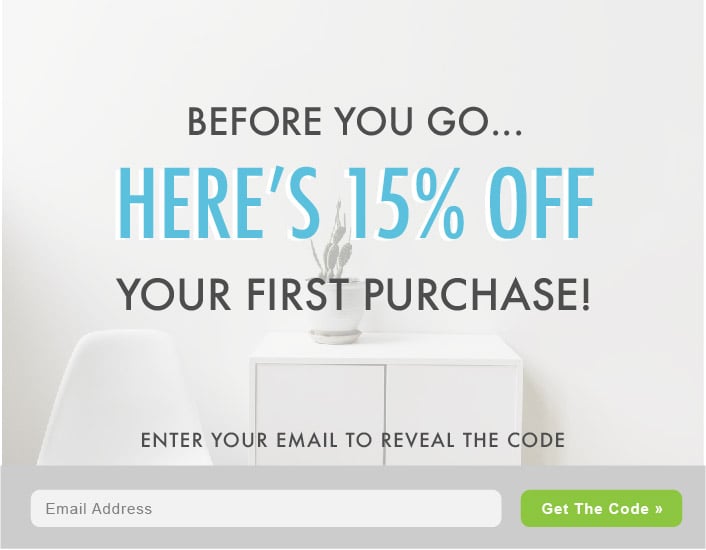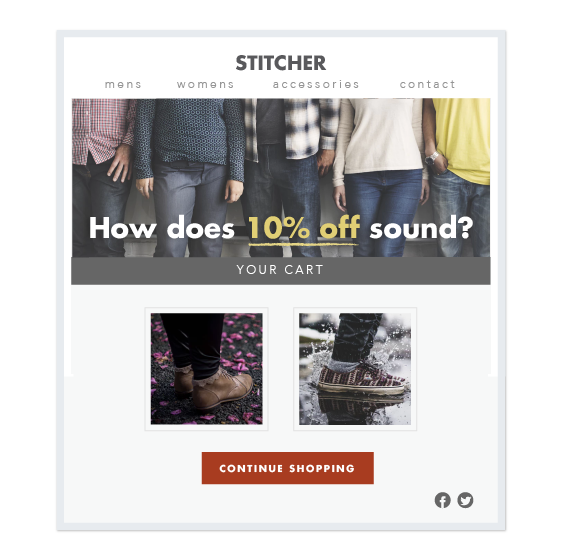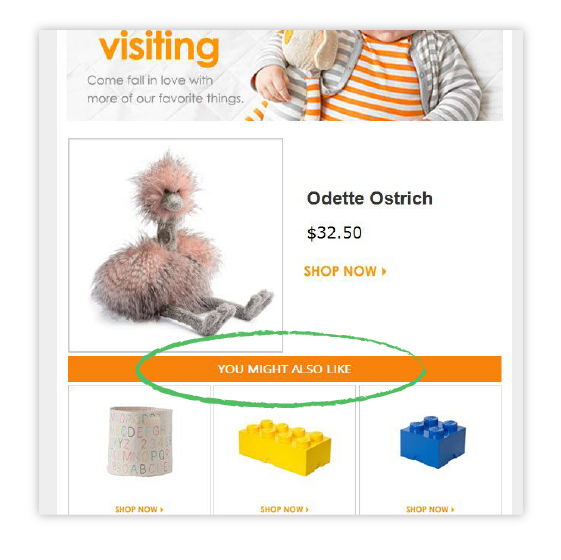The Most Economical Way to Drive More Ecommerce Traffic to Your...
By Tom Wintaugh
Read on to learn more...
 By Guest Contributor | March 16, 2018
By Guest Contributor | March 16, 2018
Want to read this blog offline?
No worries, download the PDF version now and enjoy your reading later...
Abandoned cart campaigns are popular in ecommerce marketing for good reason. Without this tactic, you stand to lose shoppers who have placed items in their cart but may have been interrupted by their kids, a phone call or are held up by indecision or price objections. Ultimately, they were this close to purchasing a product from your business. So, it makes sense to send a follow-up email soon after to remind them of items in their cart.
But, how do you reach the staggering 67-96% of shoppers who have spent time on your site, never added items to their cart? They viewed products, looked through the different options, pictured how a particular product might look in their home, but never clicked “Add to Cart.”
Does your ecommerce business have a strategy in place for reaching these “almost-customers” and encouraging them to convert?
A browse abandonment email campaign can re-engage this massive cross-section of potential customers and increase profits. Unlike cart abandonment campaigns that target customers who have placed items in their cart, a browse abandonment campaign targets “window shoppers” – customers who have shown interest, but did not make it to the cart page for unknown reasons.
Browse abandonment campaigns remind shoppers of the items they have viewed, share related items they may find interesting, and offers incentives to return and convert. Browse abandonment emails can also be used to send customers a sincere ‘thank you.’
You might be thinking, “Browse abandonment seems invasive, and I don’t want to make my customers uncomfortable.” Browse abandonment emails can garner a bad wrap because of businesses that abuse email remarketing.
Keep reading as we address the common misconceptions surrounding browse abandonment campaigns, and offer several actionable strategies for implementing your own browse abandonment campaign.
Your business needs to determine alternative ways to capture email addresses since these customers didn’t check out and provide their personal information. Here are some helpful tools to get you started.
Email provider: The ideal email service provider you choose should enable you to collect email addresses anywhere on your website and should not require a user to sign up or log in to an account.
On-site retargeting tools: Tools like Yieldify, AppSumo & OptinMonster allow you to set pop-ups for newsletter subscriptions and exit intent pop-ups that capture emails before shoppers leave your site. Popups garner more success when they offer value to customers that entice them to give you their email address. The value could range from discounts to valuable content – whatever you choose to offer should make sense for your business.

Live chat: In a recent Zendesk survey, live chat received a 92% customer satisfaction rating, eclipsing voice, email, web form, Facebook and Twitter channels. Live chat allows visitors to ask the questions keeping them from making a purchase right on your site. You can also use live chat to capture emails for your browse and cart abandonment campaigns. Learn more about the benefits of LiveChat

The old adage “timing is everything” applies here. The timing and tone of the first email communication after the shopper leaves your site is critical to the success of your browse abandonment campaign. Why? You want to reach your shoppers while the details of their visit are still fresh in their mind. The first email correspondence is typically sent to the customer thirty minutes after they leave your site.
The goal of this initial email is to remind them of what caught their eye and to offer assistance. Phrases like “Don’t forget to complete your purchase” brazenly ignores that the customer had real objections that kept them from placing items in their cart. These shoppers have a lower intent to purchase than cart abandoners – hence the reputation that abandonment campaigns can get a reputation for being pushy. Remember the phrase “gently remind and seek to serve” to help you set the tone of your first email.
Showing the customer every item they viewed on your website can portray your online business negatively. Instead, pare down the list of items and remind shoppers of the products and categories they spent the most time viewing. Be sure to include options like color, size, and quantity. You can also use this as an opportunity to showcase different product options to pique customer interest again and drive them back to your site.
The reason customers are bouncing from your site before making it to the cart may be unknown. However, you can discover what attracts customers by experimenting with different offers and incentives. A/B testing was developed as a method for determining which option a group of people prefer. Below are some ideas to help get you started.
What’s in it for them: Price is often the main reason shoppers don’t add products to their cart. As a result, straightforward coupons and discounts can be very effective when included within browse abandonment emails.

Race against the clock and other customers: Use scarcity and/or urgency tactics strategically especially since you don’t know if a customer had a strong intent to purchase.
Include other ways to pay in your abandonment emails: Consider offering alternative ways for customers to pay since cost is one of the biggest reasons that shoppers abandon ecommerce sites. For example, price negotiation services allow online shoppers to make a business an offer on products. The business can in turn, send an email that includes a phrase such as “Come back and make us an offer!” Offering payment method flexibility in browse abandonment email campaigns can help reduce price-based objections.
These days, customers have more control than ever before thanks to the explosion of new marketing channels like social media. Fortunately, marketing tactics have also become increasingly available to adapt to the customer control evolution. A machine learning-based product recommendation engine can offer a curated selection of recommended products in browse abandonment campaign emails that the customer has not yet seen. A personalized product or service offering can increase the likelihood they’ll return to your website and make a purchase.

Browse abandonment marketing is worth the investment. Your business could have a large database of customers that are on the verge of purchasing but require more convincing. Additionally, browse abandonment emails enable you to communicate to potential customers by sharing relevant content that keeps the conversation going and could eventually get them to convert. It’s also important to remember that some shoppers are simply not ready to buy despite receiving marketing collateral from your online business.
Be persistent. Continue to nurture the relationship with these customers as they’ve demonstrated an interest in what you offer. Content such as blogs, success stories, product reviews and thought leadership pieces can keep customers engaged and help to keep your brand top of mind.
Some companies have been known to abuse the privilege to communicate to customers by bombarding them with irrelevant email communications. Some may refer to this as marketing without a strategy. Remember, it’s not about what you’re doing (as long as it’s lawful), it’s how you do it.
Be sure to segment cart abandoners from your browse abandonment campaigns. Bombarding the same customer with both cart and browse abandonment emails can cause potential customers to unsubscribe and your business to be flagged for spamming.
Not all shoppers are the same. Uniform messaging should not be used to communicate with all audiences. Identify appropriate messaging for an abandoned browse and abandoned cart emails that resonate the respective audiences.
Browse abandonment campaigns are legal, effective, and allow you to reach customers who visit your site without adding the product to their carts. It’s time to re-engage with these shoppers through strategic browse abandonment campaigns and convert their interest into profit for your business.
Contributor: Colton Bradshaw of CartStack
CartStack combines the power of cart abandonment email campaigns & on-site retargeting tools to help online retailers recover 15% or more of their lost revenue, due to website dropoff. Merchants can seamlessly integrate CartStack into their Miva store. Learn more about CartStack
Love it? Share it!

Author's Bio
Guest Contributor
The Miva ecommerce platform powers some of the web’s most spectacular online stores—stores that benefit every day from our relationships with our partners and other valued providers. We work with our network of experts to create fresh, insightful content for all independent merchants. Interested in contributing to the Miva blog? Click below to learn more about our co-marketing opportunities.
Copyright © 1997 – 2024 Miva®, Miva Merchant®, MivaPay®, MivaCon®, Camp Miva®, Miva Connect®, Miva, Inc. All Rights Reserved.